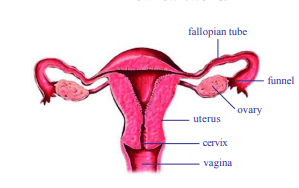Reproduction is vital in animals and plants for the continuation of life by the production of offsprings. The time required to reproduce also varies from organism to organism. In AP Class 10 Biology chapter 6 Reproduction, we shall study reproduction in animals and plants in a detailed way.
What is Reproduction?
Reproduction is the biological process by which new organisms are produced. It is important for perpetuation and continuation of life. Reproduction is classified into two types based on the fusion of gametes as follows:
- Sexual Reproduction
- Asexual Reproduction
A few examples of asexual reproduction are:
- Fragmentation
- Fission
- Budding
- Regeneration
Sexual reproduction in higher animals happens through specialised organs, distinctively male and female reproductive systems. The figure of male and female reproductive organs are given below

Image 6.1 Female Reproductive Organ

Image 6.2 Male Reproductive Organ
Cell Divison
Cell division occurs to enhance the growth of the individual to repair and replace the worn out cells and also for the formation of gametes. There are two types of cell division as follows:
- Mitosis
- Meiosis
In the next section, let us look at a few answered chapter questions to better understand the concepts discussed in the chapter.
Class 10 Biology Chapter 6 Reproduction Questions
- Explain the process of fertilisation in plants
Solution:
- The pollen grains are received by the stigma.
- The received pollen grains germinate and give rise to pollen tubes. Only one pollen tube reaches the embryosac. This pollen tube is comprised of two male nuclei, which migrate to the tip of the pollen tube at the time of fertilization.
- The pollen tube grows downward and enters the ovule through micropyle and discharges the two male gametes into the embryo sac.
- One of the male gametes fuses with an egg to form a zygote which is diploid in nature. This is known as the first fertilisation

- The other male nucleus (gamete) fuses with the secondary nucleus (2n) to form the endosperm nucleus that is triploid in nature. This is known as the second fertilisation in the embryo sac.

- Hence, double fertilisation occurs in embryosac which is unique in flowering plants.
2. What is the job of the amniotic sac?
Solution: The job of the amniotic sac is to keep the embryo soft and protect it from mechanical injuries.
3. What is fission?
Solution: It is an asexual mode of reproduction. Single celled organisms, such as Paramoecium and bacteria, reproduce by splitting into two or more offsprings. This usually occurs in a symmetrical manner. They split into two by binary fission. When more cell are formed it is called multiple fission. This is often the only mode of reproduction in these organisms.
4. How are the diseases like AIDS spread?
Solution: Diseases like AIDS are spread by unsafe sexual contacts, via using infected devices, infected blood transfusion, or from an infected mother to child.
Stay tuned to BYJU’S to get the latest notification on SSC exams, along with AP SSC model papers, exam pattern, marking scheme and more.
Comments